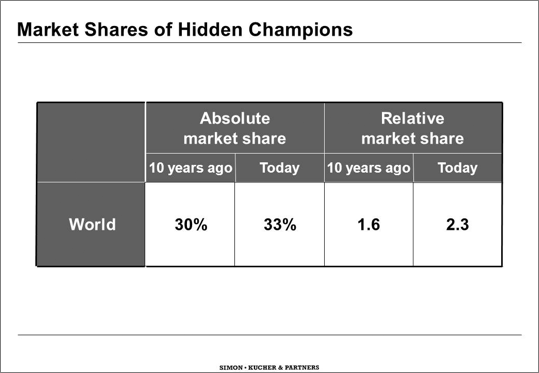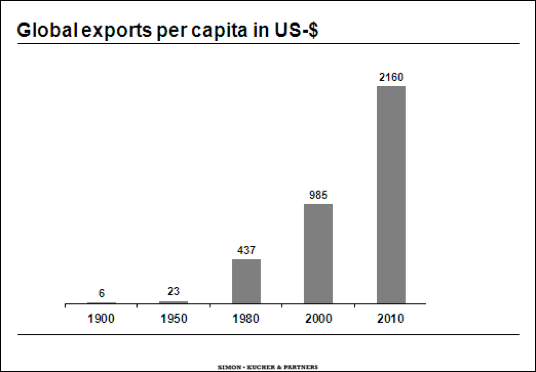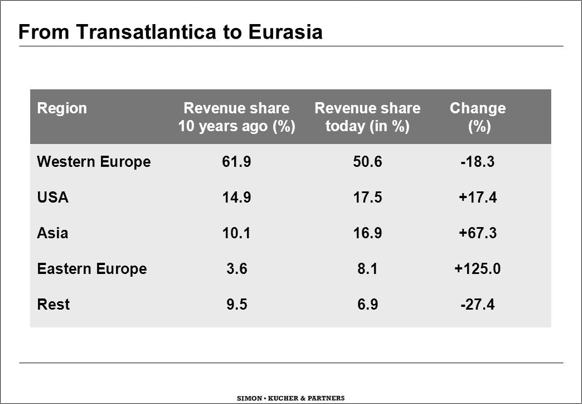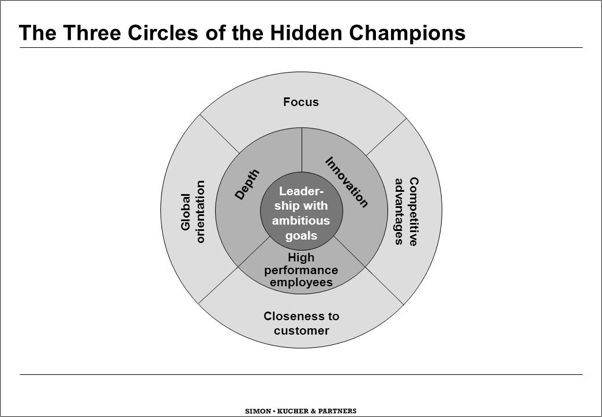Why is Germany, a comparatively small country, so strong in exports? The explanation lies in its "Hidden Champions", little known mid-sized world market leaders. My total count of these companies stands at 2,746 worldwide, and 1,307 or 47% of them are from Germany. They alone account for about one quarter of German exports. Germany was the number 1 exporter from 2003 through 2008. In 2011 its exports were $1,543 billion. Japan had exports of $801 billion. Germany alone exports almost as much as the U.K., France and Italy together. These three countries represent a population of 180 million, compared to 82 million Germans. On a per capita base, German exports in 2011 were $18,863, whereas Japanese per capita-exports amounted to $6,258.
What is a Hidden Champion?
A Hidden Champion is a company that belongs to the top three in its global market or is number 1 on its continent, has less than $5 billion in revenue and is little known to the general public. To give an example: 80% of all smart cards in the world and more than 50% of all mobile phones including the iPhone are held together by the adhesives of Delo. Delo makes special adhesives for electronic applications. Tetra is the world leader in food for ornamental fish with a 60% global market share. Belfor, an industrial service company, is a world leader in the removal of water, fire and storm damages. It is the only company that provides these services around the world.
The Hidden Champions concept increasingly attracts attention all over the world. In the last ten years, the 1,307 German Hidden Champions created one million new jobs. The majority of their employees is now outside Germany, they are truly global companies. Globalization is the most important driver of the Hidden Champions' continuing growth. The German Hidden Champions increased their global market shares in spite of a bigger world market and created a massive wave of innovation.
Seven lessons for Japan and Japanese companies
What can Japanese companies learn from the Hidden Champions? What are they doing differently from large corporations? The answer: Almost everything! Here we present the seven most important lessons from which large as well as small Japanese companies can benefit.
1. Extremely ambitious targets
The targets of Hidden Champions are aimed at growth and market leadership.
Hidden Champions set themselves extremely ambitious goals regarding market leadership and growth. An example: The goal of Chemetall is the worldwide technology and marketing leadership. Chemetall is a global leader in special metals like cesium and lithium. 3B Scientific, world leader in anatomical teaching aids, states: "We want to become and stay number 1 in the world". The Hidden Champions achieved annual growth rates of 10% in the recent decade, which means that they are 2 ½ times larger than they were ten years ago. Almost 200 $-billionaires emerged from that group in terms of revenues. Furthermore, their market shares have increased. Ten years ago their global market share was 30%, today it stands at 33%. Even more impressive is the development of the relative market share, an indicator of competitive strength, defined as own market share divided by the market share of the strongest competitor. The relative market share was 1.56 ten years ago, which means that they were on average 56% bigger than their strongest competitor. Today it is higher than 2, i.e. they are more than twice as big as their strongest competitor worldwide. The cause for this has one name: Innovation.

2. Focus and depth
Hidden Champions define their markets narrowly and work deep into the value chain.
"We always had one customer and will only have one customer in the future: the pharmaceutical industry. We only do one thing, but we do it right." This quote comes from Uhlmann, the world leader in packaging systems for the pharmaceutical industry. Flexi states: "We will do only one thing, but we do it better than anyone else." Flexi makes retractable leashes for dogs and has 70% of the global market. This is focus! And only focus leads to world class.
But focus goes even deeper. Winterhalter is a manufacturer of commercial dishwashing systems. About ten years ago they analyzed the market and found that in most sub-markets like hospitals, canteens etc. they had a market share of only 3% to 5 %. They were one among many. Then they reformulated their strategy and focused solely on dishwashing systems for hotels and restaurants. In the same vein they deepened their value chain by adding water conditioners because the quality of the water has a strong effect on the ultimate dishwashing results. They started to sell detergents under their own brand name and offer seven-days-a-week, around-the-clock service. This focus has affected everything they do. They renamed their company Winterhalter Gastronom. They have special dishwashers for high luster glasses. They recruit sales people with hotel and restaurant background who speak the language and understand the problems of their customers. They are clearly number 1 today, witnessed by the fact that McDonalds, Burger King, Hilton etc. use Winterhalter.
Closely connected to focus is a deep value chain. One of the modern buzzwords of the last 20 years has been 'outsourcing'. While many companies are proud to have delegated a lot of their production to others, the Hidden Champions have a very strong anti-outsourcing attitude when it comes to their core competencies. An example is Wanzl, world leader in shopping carts and airport baggage carts: "We produce all parts ourselves, based on the quality standards we define." Carts at airports all over the world are made by Wanzl. Obviously the airport authorities are willing to pay the high price of Wanzl. Even Narita Airport has carts made by Wanzl. They look like a simple product but the quality is extraordinary. The roots of this superior performance lie in the fact that Wanzl retains total quality control by making everything on its own.
In order to achieve a truly unique end product Hidden Champions often go two to three steps deeper in the value chain to create the processes, technologies and components which then lead to superiority and uniqueness of the end product. Uniqueness and superiority can only be created internally. If you buy something on the market everybody else can buy it too, which cannot be the way to superiority. This insight strongly counters the philosophy of outsourcing.
However, when it comes to non-core competencies Hidden Champions outsource more than larger companies. They usually don't have their own tax or legal department. "That is not our core competency but the core competency of lawyers, tax people etc. who can do better work for us in this non-core field than we ever could", they say. In a nutshell: Anti-outsourcing in core competencies, strong outsourcing in non-core competencies marks their strategy.
3. Globalization
Focus makes a market small, globalization makes it large.
The Hidden Champions see the market definition as a part of their strategy. In defining their markets narrowly they observe both customers' needs and technology. They define their markets rather deep than broad and are highly focused. This kind of focus makes the market small. But how do they manage to make the market big? By globalizing! They combine their specialization in product and know-how with global selling and marketing, which expands each market by a huge factor. If one does that, there are hardly any growth limits. Globalization has only just begun: World exports per capita, almost zero in the early 1900s, did not see much progress until the 1980s. But since then there has been an "explosion". And it is here to stay. If you go into the world, there is unlimited growth.

The Hidden Champions have their own subsidiaries in all important markets around the globe and sell directly to their customers instead of delegating their customer relations to intermediaries, agents, importers etc. Kaercher, a world leader in high pressure water cleaners, seriously started its internationalization in the 1970s and since then has added one, two and sometimes three countries to their market presence every year. It has now 75 own subsidiaries all over the world.
Due to this process we see a transformation of Hidden Champions from Transatlantic to Eurasian companies. Ten years ago 75% of the German Hidden Champions' revenue came from Europe and the USA. Today 75% is coming from Europe, Eastern Europe and Asia. Because of the stagnating economies in the US and Europe in recent years and the simultaneous growth in Asia, this shift is happening much faster than anticipated.

4. Innovation
The effectiveness of the Hidden Champions' R&D activities beats that of large corporations by a factor of 5.
One does not become and stay world market leader by imitation, only by innovation. Innovation starts with spending for research and development (R&D). R&D spending of the Hidden Champions is twice as high as in the average industrial company. Even more important is the output. Hidden Champions have five times more patents per employee than patent-intensive large corporations. And with the Hidden Champions the costs per patent are only one-fifth of the costs in large corporations. What is the driving force for innovation? Market, technology or both? 65% of the Hidden Champions state that these two forces are well-integrated and balanced, whereas only 19% of the large companies say so. The challenge of innovation is the integration of technology and customer needs. One extremely innovative company is Enercon. They have more than 30% of all patents worldwide in wind power generation. And they have exceptional ideas, such as the "E-ship" which uses so called Flettner-rotors to harness the power of the wind. The efficiency of a Flettner-rotor is 10 to 14 times higher than that of a classical sail. While larger companies throw huge budgets at solving problems, the Hidden Champions devote very few dedicated people to find new solutions. This is why their costs per patent are much lower.
5. Closeness to customer and competitive advantages
Closeness to customer is the biggest strength of the Hidden Champions, even ahead of technology.
The biggest overall strength of the Hidden Champions is not technology but the closeness to their customers. This is a natural advantage of smaller and mid-sized companies. On average 25% to 50% of their employees have regular customer contacts, compared to larger companies where only 5% to 10% have regular customer contacts. Especially pronounced is the closeness to top customers.
Grohmann Engineering makes systems for the assembly of micro-electronic products. Mr. Grohmann says: "My market is the top 30 customers in the world". Among his customers are Intel, Motorola, Bosch etc. According to Grohmann these customers are never satisfied. "They are most demanding and are always driving us to higher performance". Top customers as drivers to higher performance are a typical aspect of the Hidden Champions' customer relationships.
The strategies of the Hidden Champions are value-driven, not price-driven. They usually charge a price premium of 10% to 15% over the market average, which shows that value/quality is still the most important factor in most markets. Price becomes a central factor only if a company doesn't offer differentiated value.
The most important competitive advantage of the Hidden Champions is product quality. In recent years three new advantages have emerged: advice, systems integration and ease of use. They are the attributes with the biggest increases in importance. From a competitive point of view they are different from advantages integrated in the product, because they cannot be easily imitated or reverse engineered. These advantages reside in the brains of the employees or in the capacity of the organization to manage complexity. The barriers to entry today are probably higher than they were ten years ago.
6. Loyalty and highly-qualified employees
The Hidden Champions have "more work than heads" and high performance cultures.
The Hidden Champions have more work than heads, highly qualified employees and low turnover. The percentage of university graduates among the workforce has more than doubled from 8.5% ten years ago to 19.1% today. Since global competitiveness today is more and more about qualification it becomes increasingly important not only to hire, educate and train top talent but to retain it. The Hidden Champions have extremely low turnover rates: only 2.7% annually as compared to the average for Germany which is 7.3% for America, where on average a company loses almost a third of its employees per year and with them their know-how.
7. Strong leadership
The leadership is authoritarian in the principles, but flexible in the details.
The last and seventh lesson concerns the leaders of the Hidden Champions. They are the ultimate roots of these unusual successes. What characterizes these leaders? First and foremost, the identity of person and purpose. Leadership is ambivalent. When it comes to the principles and values, we find authoritarian leadership. There is no discussion about the principles, but strong participation and flexibility in the details of carrying out a job. The Hidden Champions have more women in top positions and a very high continuity with regard to the CEOs. Their average tenure is 20 years, compared to 6.1 years in large companies.
Summary: The Three Circles
The seven key lessons can be summarized in three circles. The core is the strong leadership with the ambitious goals. The inner strengths are depth, high performance employees, and continuous innovation. The outer circle comprises focus on a narrow market, closeness to customer, clear competitive advantages, all that with a global orientation. The ultimate lesson: The Hidden Champions of the 21st Century go their own ways, more decisively and successfully than ever. They do most things differently from the teachings of management gurus, from modern management fads, from large corporations. They are true role models for strategy and leadership in the 21st century.

Lessons for Japan and Japanese Companies
Japan does not fully exploit its export potential. It has many more large corporations than Germany. There are 68 Fortune Global 500 companies in Japan and only 34 in Germany. But Japanese exports are only about 50% of German exports. This is not due to deficiencies in technical and manufacturing competencies but to the lack of globalization of Japanese mid-sized companies. The number of Japanese Hidden Champions is only one sixth of the German number.
There are pronounced dissimilarities between Japanese and German Hidden Champions:
- The vision of the Japanese Hidden Champions is less outward-looking, but rather operational and efficiency-oriented.
- Corporate cultures, leadership styles, language are still strongly Japan-centered. The German Hidden Champions employ more foreigners and delegate responsibilities to them.
- The Japanese Hidden Champions are very risk averse. This attitude extremely limits the organizations to learn new things.
A recent study of the Fujitsu Research Institute entitled "Japan's Potential Globalizers" sheds further light on the opportunities and challenges for Japanese mid-size companies whose business is today largely confined to the Japanese domestic market.1 The study identified several hundred "potential globalizers". The potential globalizers are very strong in their domestic market, but do little international business. Surprisingly the strongest potentials are not in industrial products, but in consumer goods and health care services.
Many Japanese mid-size companies have the internal capacities and technical competencies to go global and to become hidden champions. But they are not fully exploiting these potentials because they are not internationalizing with the same vigour and speed as the German Hidden Champions. This problem is partially rooted in the culture of Japan and an attitude, which is characterized by a certain reserve against things foreign including language2, dependency on large corporations, and a preference for working as an employee rather than as an entrepreneur. These attitudes and predicaments don't change quickly. Due to this self-constraint Japan is missing many of the opportunities an accelerating globalization offers. The Hidden Champions could become role models for Japanese mid-size companies and young, ambitious entrepreneurs to pursue similar strategies. Japanese firms have the potential to be successful in the world. Decisive internationalization of mid-size firms would tremendously help Japan to overcome its export weakness and, thus, create more new and sophisticated jobs. The Hidden Champions show us the blueprint which Japanese mid-sized companies should follow.


